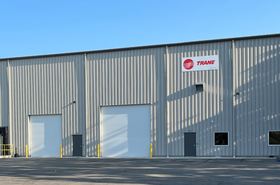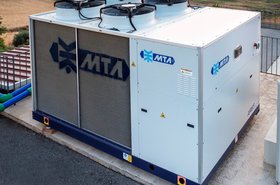As the nature of data changes, with artificial intelligence (AI) workloads becoming an increasingly common requirement for data centers, talk turns to liquid cooling, a vital component for GPUs carrying intensive loads. But is it the future of cooling? Is air cooling, which has served the industry well for forty years, on the way out?
DCD spoke to Danielle Rossi, data center strategic manager at Trane, a manufacturer and supplier of cooling technologies, which also provides training, advice, and support to operators on how to make the most of their data centers. We start with the million-dollar question: How do you make an informed choice about what’s right for you? Rossi tells us:
“That's usually a scale difference. But there are many other variables. There's whether people want air-cooled chillers on rooftops, or water-cooled chillers inside, so it’s also a question of space. But you don't have to do one or the other – you can have a hybrid design.”
You may already know that, right now, liquid cooling is excessive for your needs. But Rossi is keen to point out that this isn’t the time for short-term mindsets:
“People need to consider the five to 10-year plan. We need more conversations on the planning side about what future goals are, or, if you're a colocation facility, having that conversation with your customers – not only what do you need today, but what do you need in five years?”
This is an important point because it affects design decisions, which need to be resolved as early as possible:
“If you don't include any stipulations for any type of liquid cooling going forward, such as breaks in the walls, then you either accept it’s not an option for that facility, or you have to retrofit later which is much more expensive, and could cause downtime, depending on your situation.”
Rossi goes on to explain some of the factors in the decision-making process:
“What is your ultimate goal? Hybrid designs tend to work well if you don't know what you want. Then, down the road, you have the flexibility to change. It may be more expensive upfront but it all depends on the remaining lifespan of the data center, or it's worth the extra X amount now so you don't have to make changes later.”
The inevitable question, however, is whether Rossi subscribes to those who believe that liquid cooling is the future, and air cooling is on the way out. The answer is a firm ‘no’.
“Air cooling is not going anywhere for a while. Enterprise data centers are a large part of the data center population that don’t need large cooling. To say that it's just all gonna go away and be liquid is not reasonable. Individual applications with an extremely high density might be liquid-cooled. In reality, it's going to be a combination.”
Industry stalwarts may be under the impression that air cooling has, unlike the air in the room, stagnated. Rossi will tell you that nothing could be further from the truth. She recalls:
“In a previous life, I sold air cooling, and there was a big change. It was perimeter cooling from the early 80s. We moved from belt and pulley to direct drive fans. But the big change was row cooling, which gives you the capability for very high densities. I've had 40-50 kW racks that are successfully row-cooled. So – do you need liquid cooling? Can your hybrid design include containment or contained perimeter units?”
In part two of our interview with Danielle Rossi (coming soon) we look further into the sustainability issues that surround cooling. But as she points out, there are multiple factors at play, such as TCO (total cost of ownership):
“It's not a completely fair comparison. With row cooling, using VLANs, one rack might be 40kW, and another rack might be 20. The only direct comparison is the amount of energy spent versus the cooling provided, and liquids are probably going to win every time. But what about the construction costs involved in completely changing the layout of your data center?”
Typically, the conversation is currently centered on the assumption that liquid cooling will always be a step up. With that in mind, we ask Rossi if there are any advantages to investing in modern air cooling instead. She warns us that, again, it’s not a straightforward answer:
“It depends on what you're doing. It can be cheaper, but it can also be more expensive, which is confusing. It's dependent on the availability of load versus the space, what loads you're going to be working with, and even predicted future demand. There are a lot of things to include.”
However, as she points out, one of the biggest is the age-old question of how to perform maintenance on a data center without creating downtime, and here, she illustrates the downside of this new world of liquid:
“In a cold liquid cooling system, to go in the rack that is single-phase immersion, it's oil-based, which makes day-to-day maintenance very frustrating. With a two-phase, it's hermetically sealed. You have to get in and out and then worry about potential fluid loss.”
This represents another on Rossi’s list of misconceptions about liquid:
“People tend to think that it's the same thing as working in a normal data center when there’s a lot more to think about. Consider how you want to function within your data center. Direct-to-chip has the same layout as your standard data center, but you still have to unhook servers or access CPUs and pumps so consider the cost differential.”
Every country has different legislation, particularly in the age of sustainability. That means “one-size-fits-all” is definitely off the table, and with new laws being passed all the time, that forward-planning mantra comes into play again. Rossi tells us:
“Part of it is that there's a lack of regulation right now. Not only is there no industry standard, but there's no single company standard. Cooling manufacturers don't know what to provide, and all of a sudden people are saying they were going to decide they wanted something, and no one's making it because they didn't a year ago. That’s where planning helps everyone.”
In summing up, Rossi re-emphasizes that the secret sauce is in the planning:
“It's an interesting world right now because everyone thinks that they're going to be wearing liquid cooling. When? Do you know what it is? To do what? What type do you want?” she jokes.
“There's so much to talk about around liquid cooling right now. People need to focus more on what their needs are going forward. There are a lot of people who are talking about it, not making plans. That's probably my biggest thing – what do you need for this to go forward? What steps are you taking to make requirements or ensure that you're going to have the right specifications going forward? That is a pretty big gap right now.”
To learn how Trane is improving how data centers are developed, designed, and operated, click here.
More from Trane Technologies
-

Sponsored Trane by Trane Technologies expands manufacturing operations in Grand Rapids, Michigan to address growth in data center and high tech markets
New location nearly quadruples Trane’s commercial production space in the region
-

Cooling fit for the future
Examining the challenges that come with future proofing our facilities
-

Trane Technologies acquires cooling company MTA
HVAC company expands with acquisition

